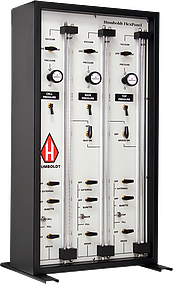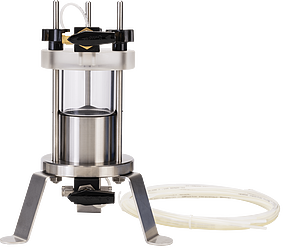The HM-4160A auxiliary panel provides additional sets of burettes for 2 cells, which can be used to expand the capacity of a system. Each set of three (3) burettes provide the controls necessary for another cell to be used. The HM-4160A provides two (2) sets of (3) burettes. Humboldt recommends any combination of up to five (5) burettes sets can be used with each control panel.
Permeability testing measures the rate of discharge of water under laminar flow conditions through a unit cross-sectional area of a porous medium under a unit hydraulic gradient and standard (20°C) temperature conditions. In permeability testing, soil is subjected to water under a known pressure, and the flow is measured. The coefficient of permeability (k), or simply permeability, expresses the ability of water to flow through the particular medium. The “constant head” test method is applicable to course granular soils such as sands and gravels. The “falling head” test method is applicable to fine grain soils. Either method may be used to test clay soils.
Humboldt FlexPanels
Humboldt FlexPanels provide a simple and highly efficient distribution system for providing air, water and de-aired water for use in permeability and triaxial testing applications. The FlexPanel’s simple, straight-forward configuration, with its integral burettes provides a condensed/compact design that takes up less counter space than competing systems with air/water bladders. The long, narrow burette design of Humboldt's FlexPanels provide faster test processing times when compared to larger, shorter burette systems, while providing the same volume. This is due to the reduced amount of meniscus formation in the narrower burettes, which allows the water level to drop faster, resulting in faster readings. In addition, the use of longer/narrower burettes and a scale graduation of 0.02ml, also provides an easier-to-read and more accurate scale.
FlexPanels also feature a bias regulator and bridge. The bias regulator maintains the differential pressure when confining and back pressures are increased. The bridge delivers simultaneous control of base and top pressures through the use of just one regulator. This feature minimizes operator time and reduces the margin of error in opening and adjusting regulators during a test. The Humboldt FlexPanel system is comprised of 5 separate panel configurations, which can be grouped together to accommodate from 1 to 6 cell setups.
Fast and Easy Setup and Operation
Humboldt FlexPanels make setup fast and easy with clearly labeled ports and quick-connect hookups. Operation is just as easy with clearly labeled controls, large gauges and easy-to-read burette markings. All Humboldt FlexPanels use no-volume change Swagelock valves and Fairchild constant-bleed type precision regulators for accurate control. All inlets and outlets utilize quick-connects to ensure fast, accurate setup to permeameter cells, as well as air, water and drain hook ups. Fittings, tubing and connectors are supplied with each unit. All FlexPanels are designed to handle air pressures up to 150 psi. For testing contaminated samples, Humboldt offers an optional Toxic Interface Unit, which prevents toxic fluids and vapors from entering the FlexPanel. See facing page.
Humboldt FlexPanels Features:
Humboldt FlexPanels are constructed of lightweight aluminum for long, rust-free life. FlexPanels provide an accurate and easy-to-operate solution for controlling compressed air, water, de-aired water and vacuum without the need for air/water bladder interfaces to produce the pressures necessary for permeability and triaxial testing. FlexPanels utilize a set of three burettes to control cell, top cap and base pedestal pressures. This extremely versatile pressure system controls the pressure, water, de-airing tank and vacuum from a single panel. The three burettes allow for the control of the cell pressure and the back pressure for each cell. They can monitor volume change in the sample and can be used to measure the flow of water through the sample for permeability testing. FlexPanels can manually measure volume change or permeability in a triaxial test sample without the use of a volume change apparatus, a distinct benefit when compared to air/water bladder systems.







